***Apologies if this is in the wrong category, somehow GAG is not allowing me to post it in the category of my choosing, hopefully an admin or mod can correct this issue.***
The following are some notes I took while educating myself on how to become a better pet owner. I want to share this helpful information with as many people as I can because I am confident this is very helpful in understanding and taking proper care of pets (mainly dogs). I hope everyone who gets to read this will be able to build a better relationship with its pet/s, enjoy even more the experience of having a pet and for the dog to have a better, healthier, and happier life.

*A
---------- 16 Useful clues to understanding your dog better ----------
The following interprets some dog's body movements.
1.Dog waves his lowered tail:
Slowly - Dog doesn't know what is going on, asking what you want him to do.
Rapidly - he admits you are in charge.
2. Tail raise up: He is proud and showing authority.
3.Tail between legs: When afraid of something or someone, take him to the vet if it doesn't go away.
4.Eyes wide and open: He is challenging you; respond firmly. Be careful when dogs you don't know do this.
5. Dog squints and blinks: He is ready to play or his eyes might be in pain.
6.Ears straight up: He is curious and open to action.
7.Flattened ears and against the head: He is scared, afraid of people or intimidated by unknown people.
8. He yawns: When nervous or sleepy. He can mimic you if he is too attached to you.
9. He licks his face: When stressed, feeling pressure, danger, or to calm an aggressor.
10. Shows teeth (no snarling): protecting his territory, especially when eating.
11. Rolls over and shows belly: Trust you and wants to please you.
12. The dog places his head on your knee: Dog wants attention and he needs you! If he touches your hand with his nose he wants to get ped.
13.Paw in your knee: Trying to dominate you, so look at his eyes and remove paw.
14.One pawn raise: He asking you for something; usually food or to play.
15. Shows you his back: He trusts you a load.
16. Dog shake: To release tension accumulated or given by a person or dog.
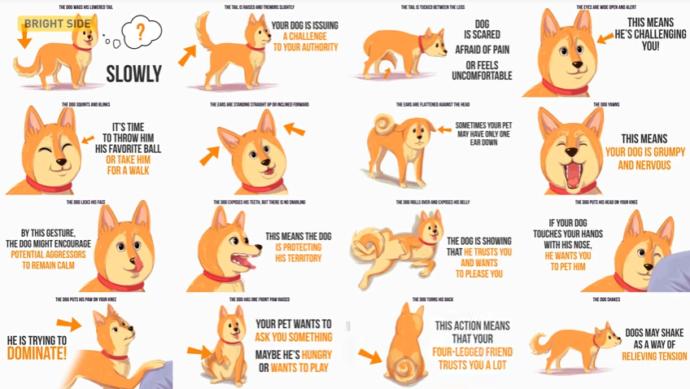
------- Behaviour explained: Understanding your dog better -------
10. Why dogs sniff other dogs butts: He is collecting detailed info as gender, reproduction status, healthy level, what he had for breakfast. In the dog world is as acceptable as saying hello or asking a question.
9. Why dog walks in circles before lying down: A habits that reside in genes, a ritual left over from when creatures lived in the wild. They nested by padding down debris and branches, ext. Overdone can be a sign of obsessive-compulsive disorder.
8. Why dogs hump: Younger dogs do it more often for attention if not neuter. But when neuter or dog is mature is showing dominance or over-excitement. it is acceptable for them, just redirect pet attention to stop.
7. Why drag butt on the floor: It is normal for them, can be to clean after going to the bathroom, a sign of health problems as tapeworm, or problems in the anal glands.
6. Chase own tail: To get rid of excess energy, catch attention, injure (as a slam in the door), parasite bite, skin irritation, anxiety, psychological issues, or excessive compulsive disorder.
5. Why tilt head when looking at me: When high pick or whistle sound is made they tilt their head to make sense in what they are hearing, distinguishing words, or finding where the sound comes from. Tilting the head all the time is a health problem.
4. Why dogs eat grass: Can be boredom when young, improve digestion, treat intestine worms, need for fiber, or just like the taste of fresh grass.
3. Why leg shakes when scratched: Is involuntary when scratched in a nerve spot.
2. Why dog howls: Wolfs did it to send a message or enforce ranks, modern dogs do it as a passable habit and is rewarding for them
1. Why dog keeps staring at me: Eyes never leave you because he is waiting for you to give a treat or show affection. If dogs don't know you and they are staring it can be signs of a challenge.
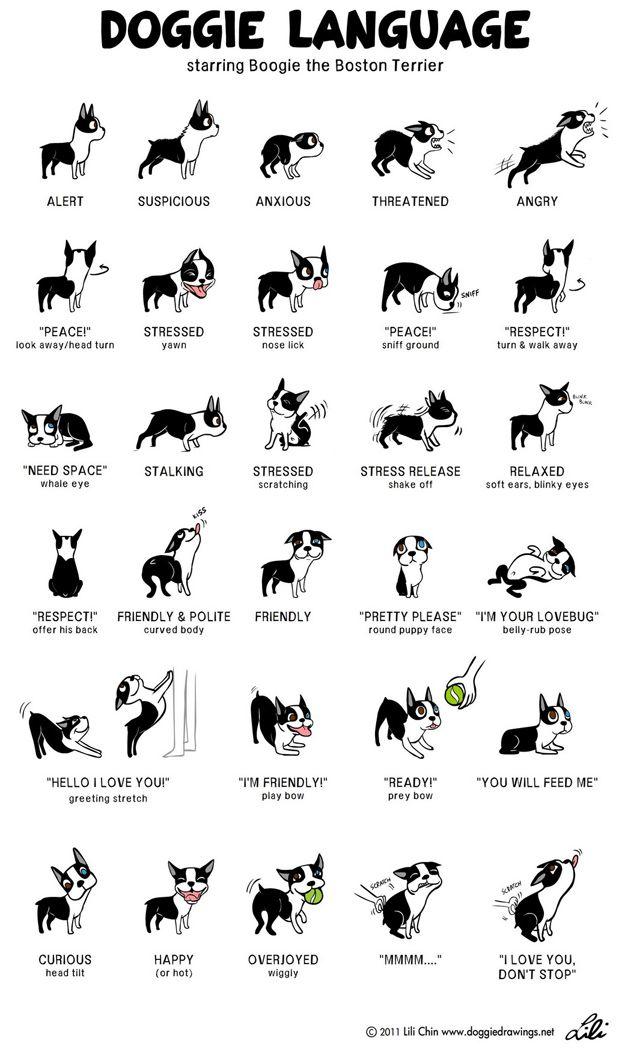



--- 12 Harmful things you do to your dog without realizing it ---
Be considerate with your dog, and pay attention to these acts.
12. Choose the wrong collar:
Flat collar: Most widespread for indoor use.
Breakaway collar: Preferably for outdoor dogs.
Special collars for dog training: Not recommended for young pups.
Harness: If he likes to explorer or pulls a load.
Size: In small and medium dogs one finger should be able to fit between the collar and the neck. For large and extra large dogs two fingers should fit between his neck and the collar.
11. Leaving a dog alone in the car: Temp can rise 20 degrees in 10 minutes. Dogs don't sweat they can overheat and die. Symptoms of heat stroke are agitation, drooling, vomit and diarrhea.
10. Neglecting teeth: They need to be wash x3/week(daily is best, chopsticks will not replace it) There are special toothbrushes and pasta for them, plastic bones help in dental hygiene. They need dental clean ups x2/year.
9. Letting them eat everything: never feed human food, is too salty, spicy or fatty and most is toxic.
8. Bring puppy to dog parks: Small puppies can get diseases from larger dogs, play can be very rough, puppies can get scared or hurt.
7. Physical punishment: doesn't work, is animal abuse, reward-based training help build trust, punishment distrust owner. He hides and gets super scared when knowing he is going to get hit they only focus on getting hit not what they did wrong, obedience school is great especially when they are young.
6. Providing too little stimulation: They need constant stimulation or they can create mess at home, especially working breeds, they need constant walks, exposure to smells and other dogs.
5. Not securing dogs in the car: He can get injure or kill in an accident; there are different types.
4. Yelling when a dog has done something wrong: they don't understand and doesn't work for discipline; he will be scare and confused.
3. Skipping thick fleed and worm treatment: Is iresponsable, discuss it with a vet in cold climates.
2.Leaving harmful objects around: Don't leave medicine, nails screws, magnets, cons, batteries, small socks, etc in their reach.
1. Neglecting breed-specific health issue: Each dog type has it own grooming and predisposition to certain health issues.
-------------------- 12 things your dog hates about you --------------------
No matter how much we love our pets, there will be times when they will get mad at us without us knowing why. The following actions can help us understand dogs better and avoid getting them mad.
12. Hugging them: They don't like it, they put legs on the shoulder of others as hugs. Our hugs is a dominance move for them and they don't like it.
11. Using words more than body language: they read gestures to know what we want, make small gestures with keywords.
10. Padding their heads: They don't enjoy it, because their personal space is invaded.
9. Keeping long eye contact: You can stare as long as want to your dog, but not to one you don't know because they can become aggressive.
8. Lacking rules and structure: They want organized routines and want to know what limits they have. Better for them to stick to rules.
7. Keeping them on a tight leash: Holding it tight stresses them because they feel you are stressed.
6. Not letting them explore and smell: They love exploring let them do so.
5. Forcing them to interact with people or dogs they don't like: Is Counterproductive, they will be bitter and resistant when pushing them to interact with dogs of different personalities or forcing them to interact when they don't want to.
4. Being tense: They mimic how we feel, most of the time the more anxious you are the more they become.
3. Being boring: It is a nightmare for a dog to be bored, they don't like inactive owners.
2. Exposing them to strong smells: They are more sensitive, they didn't like strong scents
1. Bathing them: they don't like the strange sound, wet fur, and slippery tub. Try to make bathing a good time.
-------------------- How to know if your pet needs help --------------------
Because your pet can't talk to you when there is something wrong, you need to pay close attention to his body and behavior. Always keep an eye for the following:
1. Change in the gums color:
Pink is normal for dogs and cats, change in color can mean: high fever, infection, lack of hygiene, liver problems, loss of blood.
2. Hiding: Severe stress can be a reason or not feeling well. For cats hiding is natural.
3. Changes in the appearance of the eyes: Red eyes or excess in secretion can mean a virus and bacteria infection in dogs. Clear secretion in eyes in cats means a virus, if the liquid is green or yellow we are dealing with an infection.
4. Lethargy: Not interested in playing with toys, give him an alone time or resting. If it doesn't go away in 24-48 hours it can mean fever, dehydration or heart disease.
5. Sudden aggression: Can be pain, dental issues, arthritis, injuries, or an infection.
if not done anything to him
6. Inconsistency in stools: Is alarming especially if his diet is consistent. If vomiting or diarrhea occurs go to vet.
7. Occasional vomiting: Means nothing, could be hairballs or trash from walking. A few times in a row can mean internal trauma or a blockage
8. Changes in drinking habits: Cats don't need to constantly drink water if their food is wet, dogs do. If cat or dog is not drinking water check for leaks around the house or he insists take it to the vet. Excessive drinking can mean diabetes or kidney disease.
9. The loss in appetite: For more than 24hrs could mean infection, tumor, gastric diseases, or parasites. Never starve cats, even when fat!
10. The coat is altered: For cats when they are not strong enough to lick themselves. Dogs shed too much hair means allergies or skin diseases.
11. Breathing problems: Breathing rapidly can be liquid in chest or heart problem. Also can occur from overfeeding him.
12. Staring at a wall: Check for insects, if not, then call animal if he ignores you it is alarming. Can be a tumor, stroke, or head problems.
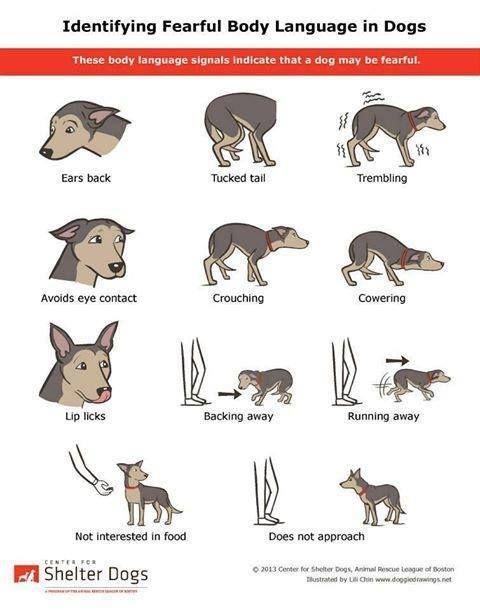

-------------------- 10 foods you shouldn't give your pet --------------------
10. Onions and Garlic: Plants and vegetables in onion family contain propyl disulfide.
Symptoms: Appears in several days, Nausea, vomiting, diarrhea, lethargy, abdominal pain, increased heart rate.
Effects: Destroys animal blood cells causing anemia.
9. Lilies: Some are extremely toxic.
Symptoms: Lost of appetite, vomiting, excess urination, increased salivation.
Effects: Can destroy kidneys, can irritate the mouth and upset stomach.
Treatment: Give them something tasty, canned chicken broth help flush crystals out of their mouth and clean up.
8. Avocados: Contains the fungus toxin Persin; mild level of toxicity.
Symptoms & Effects: Gastrointestinal problems, breathing problems, and heart issues.
7. Coffee and chocolate:
Caffeine has moderate to several toxicity levels.
Symptoms: Elevated heath rate, increase body temperature, excessive urination, dehydration, tremors, seizures, death.
Chocolate: Contains Theobromine a toxin to animals.
Symptoms: Digestive issues, not drinking water, low heart rate, seizures, and death.
6. Bones: Generally are good, but be careful which type you give your pet:
Prohibited: Poultry bones, chicken, turkey and pork bones can splinter into shards that can cause choking and serious damage to the dog's mouth, throat, or intestines. Cooked bones are forbidden as well.
Raw bones: Don't let him chew it for more than 15 minutes, place in refrigerator afterward. And throw it away after 3 or 4 days of use. Bones should be larger than the dogs head.
5. Apples, seeds, cherries & other fruits: Red apples in particular cause allergic reaction because the seeds contain cyanide.
Symptoms: Vomiting, Diarrhea, Dehydration.
4. Tomatoes: Papatoes and eggplant contain Solanine.
Symptoms: Digestive problems, Loss of coordination, Muscle weakness, tremors, and seizures.
3. Raw eggs: Contains Avidin which disrupts the metabolism of vitamin b and produces dry rashy skin. It can also contain bacteria contaminations such as salmonella or e.coli.
2. Grapes and raisins: toxicity is high! Just half an ounce can poison a 10-pound dog.
Symptoms: Lethargy, loss of appetite, diarrhea, vomiting, and dehydration.
Effects: Damage in the kidneys
1. Ice cream: Contains milk and sugar. Most adult animals are lactose intolerant.
Even tho toxicity is low; diarrhea, vomiting, gastrointestinal issues and dental problems can result from eating it.

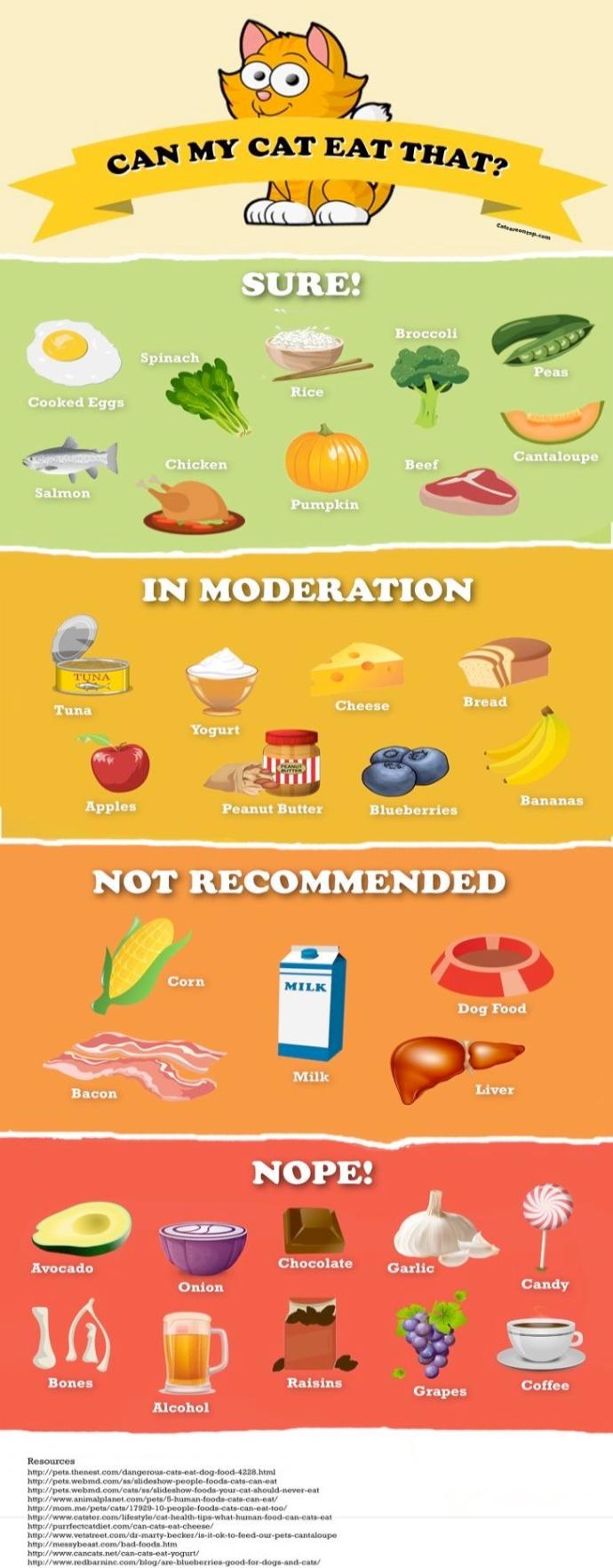
*B.
-------------------- How to tell your dog you love him --------------------
1. Get to know your dog: Each dog is unique with a unique personality. Learning what they like and don't like is one of the best ways to show you care and love him.
2. Training and education: Is fundamental for mental health! Helps channel energy correctly and teach how to play nice with others.
3. Learn to say I love you: Dogs are about body language, they show it by following you around and sleeping around you. You can show your love by accepting they affection and giving some back.
4. Dedicate quality time to your dog: Take some time for intense fun and cuddling.
5. Prepare his favorite dish: I personally believe this feeling is universal (:
6. Spoil them with confidence: Don't overprotect your dog, let them play with other and keep him on a loose leash.
3. Respect dogs nature: Let them be dogs, sniff urine, eat dirty, jump around and be active.
*C.
-------------------- 5 ways to know your dog loves you --------------------
Based on: Neuroscientist and author Gregory Burns book, "How dogs love us"
1. Dog cuddles up with you after eating: Dogs are driven by food, but their next action is driven by the impulse of what matters for them? Cuddling with you after eating is a very good sign.
2. Where your dog sleeps: Many people don't want dogs to sleep in the bed, but this action shows your dog wants to stay in the pack.
3. Does your dog freaks out when you leave: Freaking out can be caused by separation anxiety. If he goes into his crate he loves you, is accepting you are leaving and trust you will come back.
4. Does dog freaks out when you come home: They love you when they try to jump all over you even after been fed.
5. Do you love your dog: Dogs can sense if you love them, if you want to receive love back, make sure to give it first.
*D.
------------------------- How to properly pet animals -------------------------

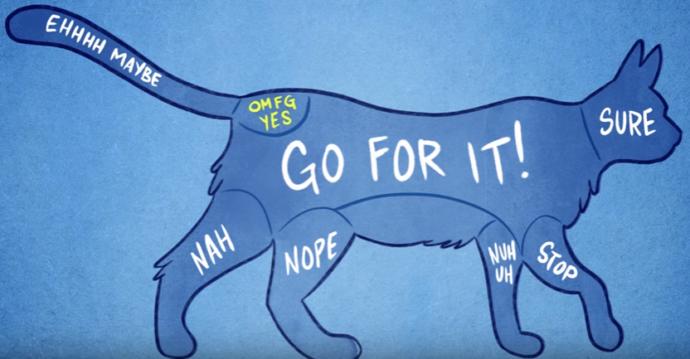

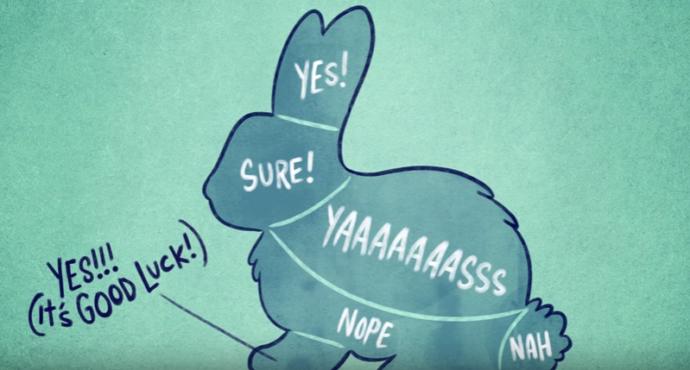

Extras:-----------------------------------------------------------------
{ U.S.A: ASPCA ($65 USD) & PPH ($59 USD) as of Aug. 2018}
"The ASPCA Animal Poison Control Center (APCC) is your best resource for any animal poison-related emergency, 24 hours a day, 365 days a year. If you think your pet may have ingested a potentially poisonous substance, call (888) 426-4435. A $65 consultation fee may be applied to your credit card." (https://www.aspca.org/pet-care/animal-poison-control)
Pet poison helpline: (855) 764-7661 or https://www.petpoisonhelpline.com/
"Did your pet just eat something poisonous? Call your veterinarian or Pet Poison Helpline immediately. The sooner a pet poisoning is diagnosed, the easier, less expensive, and safer it is to treat."
A must read: (https://www.wikihow.com/Recognize-Poisoning-in-Dogs)
Top 10 Dog Poisons (https://pets.webmd.com/dogs/guide/top-10-dog-poisons#1)
Dog poison No. 1: Prescription medications for people.
Dog poison No. 2: Insecticides.
Dog poison No. 3: Over-the-counter medications.
Dog poison No. 4: Pet medications.
Dog poison No. 5: Household products.
Dog poison No. 6: People food.
Dog poison No. 7: Chocolate.
Dog poison No. 9: Rodenticides
Dog poison No. 10: Lawn and garden products.
"What to do for suspected dog poisoning:
If you think your dog has been poisoned, try to stay calm. It is important to act quickly, but rationally.
First, gather up any of the potential poison that remains -- this may be helpful to your veterinarian and any outside experts who assist with the case. If your dog has vomited, collect the sample in case your veterinarian needs to see it.
Then, try to keep your pet calm and call your veterinarian or the ASPCA Animal Poison Control Center (APCC) at (888) 426-4435. Experts at the APCC are available to answer questions and provide guidance 24 hours a day for a $60 consultation fee. Another option is the Pet Poison Hotline with a fee of $59 per incident."
Symptoms of Dog Poisoning (https://dogs.lovetoknow.com/wiki/Symptoms_of_Dog_Poisoning)
1. Loss of Appetite
2. Drooling
3. Vomiting
4. Diarrhea
5. Rash or irritation at the Contact Site
6.Lethargy
7. Loss of Coordination
8. Tremors or Seizures
9. Labored Breathing
10. Sensitivity to Light
11. Onset of Organ Failure
12. Loss of Consciousness
13. Nonresponsive Behavior
14. Coma
15. Death (Antifreeze & Snail/slug bait & Mouse/rat bait & Prescription medications)
"Immediate Measures to Take:
Try to identify whichever toxin your dog may have come in contact with. This knowledge could save your vet valuable time in formulating a treatment plan.
Call your vet right away and do your best to describe the exact symptoms.
Follow any directions your vet advises. For example, most vets will advise you to refrain from inducing vomiting because it can actually make the situation worse. In other cases, a vet may advise you to feed your dog activated charcoal to begin absorbing a particular toxin. Above all, never decide how to treat your dog on your own without the explicit advice of your vet.
Take your dog in immediately for treatment unless your vet advises otherwise.
If your veterinarian is not available, call the ASPCA Animal Poison Control Center at 1-888-426-4435."
How To Know If Your Dog Has Been Poisoned (https://www.globalanimal.org/2013/10/25/how-to-know-if-your-dog-has-been-poisoned/)
1. Verify the color of your dog’s gums.
2. Watch your dog’s balance.
3. Examine your dog’s bodily functions to check for irregularities.
4. Listen to your dog’s lungs for signs of respiratory distress.
5. Take your dog’s temperature with a thermometer designed for animals.
6. Watch for signs of sudden appetite loss.
7. Check your home and yard for potential dog poisons.
8. Write down your dog’s symptoms in detail.
9. Call your veterinarian.
Has Your Dog Been Poisoned? 20 Ways to Tell (https://www.vetinfo.com/dog-been-poisoned.html)
20 Typical Signs of Poisoning
1.Mouth irritation
2.Swollen mouth or throat
3.Vomiting/diarrhea
4.Irregular heartbeat
5.Dilated pupils
6.Difficulty breathing
7.Pale gums
8.Swollen abdomen
9.Muscle tremors
10.Hyperactivity/Weakness
11.Bloody/painful urination or defecation
12.Bleeding from any orifice
13.Confusion
14.Restlessness/Pacing
15.Blindness
16.Paralysis
17.Seizures
18.Coma
19.Cardiac arrest
20.Death

Sources:-----------------------------------------------------------
A. Bright Side (https://www.youtube.com/channel/UC4rlAVgAK0SGk-yTfe48Qpw)
B. AnimalWised (https://www.youtube.com/channel/UCehBsZIPmlXUedqF9bKRSqw)
C. Wall Street Journal (https://www.youtube.com/channel/UCK7tptUDHh-RYDsdxO1-5QQ)
D. BuzzFeedVideo (https://www.youtube.com/channel/UCpko_-a4wgz2u_DgDgd9fqA)
Disclamer: I dont own any of the images use in this article nor i want to take credit for them. I am using them to educate people about the responsabilities of owning a pet. All the image credit goes to the respective owners.
Most Helpful Opinions